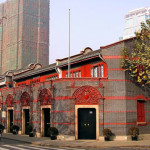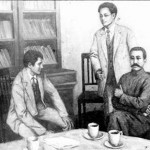
The Chinese Communist Party (CCP) was founded in 1921 by writers and political activists who had participated in the May Fourth Movement. Seeking an alternative path for China’s political development, these men turned to the writings of Karl Marx and the example provided by Bolshevik revolutionaries in Russia. In its first years the CCP was small and relatively insignificant. Just a dozen people attended the party’s first congress in 1921 and by January 1925 its total membership was still less than 1,000 people. During this early period the CCP’s ideology, organisation and tactics were determined not by its Chinese members but by the Communist International in Moscow. In the early 1920s Moscow considered the CCP too weak and underdeveloped to be a revolutionary party in its own right, so CCP members were directed to join the nationalist Guomindang and support its quest for national reunification. The First United Front – a political and military collaboration between the Comintern, the CCP and the Guomindang – was negotiated by Sun Yixian and Adolph Joffe in 1923. Ideological differences between communists and right wing militarists in the Guomindang made the First United Front an often uncomfortable alliance – but from a communist perspective it achieved the reunification of China, while providing the CCP with military training, opportunities for recruitment and an awareness of the Guomindang, its future rival for power.
Chinese reformists and radicals had long been curious about and receptive to Western political ideologies. The American liberal John Dewey visited China in 1919 at the height of the May Fourth Movement, while British philosopher Bertrand Russell also spent a year in China in 1920. Between them they delivered more than 300 lectures to Chinese audiences. More radical political and literary groups, disgruntled with China’s treatment by the Western powers in 1919, looked beyond Anglo-American political models and ideologies. Some turned to the German writers Karl Marx and Friedrich Engels, whose works The Communist Manifesto (1848) and Das Kapital (1867) advanced strong and well argued criticisms of European capitalism and the political systems that supported it. These works gave rise to an entirely new political ideology: communism, also known as Marxism after its chief creator. The tenets of communism promised a new kind of society, where class exploitation and oppression would disappear. Marxist ideas were further adapted by the Russian revolutionary Vladimir Ulyanov, or Lenin, who argued that imperialism – the subjugation and economic exploitation of weak nations by stronger nations – was simply an end result of capitalism. A socialist government, both Marx and Lenin argued, would eradicate imperialism and rule on behalf of the working classes of all nations, rather than a privileged few. In October 1917 Lenin and his followers moved to put their theory into practice when they seized control of the national government of Russia.

Marxist-Leninist theories had obvious appeal for Chinese radicals. Marx and Lenin may have been a Westerners but they provided a stinging condemnation of Western imperialism and a lucid explanation of what had happened in China. The broken promises of Versailles and the reluctance of Western nations to relinquish their grip on China seemed to validate Lenin’s theories on imperialism. The May Fourth Movement further weakened China’s fascination with Western democracy and constitutional government, leading some political and literary groups to study and discuss Marxist texts. The most fertile ground for this rising interest in Marxism was Shanghai, China’s most Westernised and industrialised city and the third-largest city in Asia. Shanghai was a city of enormous contrasts. Western cultures sat alongside Chinese culture, affluence alongside poverty, capitalist excess alongside the exploitation of workers. By 1919 the city had a left wing newspaper, the Shanghai Chronicle, funded by Russians and Western expatriates sympathetic to socialism. By the summer of 1920 Marxist ideology was being widely discussed by literary groups in Shanghai. In September that year Chen Duxiu, later a founding member of the CCP, wrote that China needed to “establish by revolutionary means a state of the working class (proletariat) in order to create a government and laws [to] put a stop to internal and external pillaging”.
This developing interest was encouraged and supported by a Soviet Russian agency called the Comintern (or Communist International). The Comintern was formed in Moscow in March 1919 to advance communism and support communist groups around the globe. In early 1920 the Comintern established the Far Eastern Bureau, a subcommittee tasked with starting and assisting communist groups in Asia. One of the first Comintern agents sent to China was 26-year-old Grigori Voitinsky, who arrived in Shanghai in June 1920. Voitinsky met frequently with Duxiu and Li Dazhao, another CCP founder, and advised them on the logistics of establishing a communist party. By the end of 1920 this group had drafted its own party manifesto, started a newsletter and formed communist-oriented labour and youth groups. Some historians consider these the first actions of the Chinese Communist Party – however the CCP was not formally constituted until its first congress in July 1921. This meeting, attended by just 12 delegates representing 59 party members, was started in a girls’ school in Shanghai’s French quarter but had to be moved to a boat on South Lake to avoid police raids. Among those in attendance were future leaders Wang Jingwei and Mao Zedong, as well as Henk Sneevliet, a Dutch representative of the Comintern.
“The Chinese family was still all-powerful and claimed all individual loyalties. In the words of Lin Yu t’ang, it was a ‘walled castle outside which everything is legitimate loot’. The clan, the family, the guild, the village were infinitely more important than the nation and the state… Chinese Communists put themselves at a considerable advantage by a violent attack on the family, which ceased to exist in the eyes of the Party. This won the undivided loyalty of their members…”
Jacques Guillermaz, historian
In its first three years the CCP was weak and ineffective, chiefly because of its size (the 59 members of July 1921 had only increased to about 300 a year later). The party was also ideologically divided: some members were orthodox Marxists who believed that revolutionary energy came from the proletariat (industrial workforce), while others, like Hunan’s Mao Zedong, viewed the peasantry as China’s most potential revolutionary group. The Comintern, frustrated by the slow growth and development of the CCP, considered it incapable of acting on its own. From Moscow’s perspective the CCP’s best role was to assist the forces of democratic revolution, as China transitioned from Qing feudalism to a Western-style constitutional government. In 1922 Comintern agents directed CCP members to also take up individual membership of the Guomindang. They were instructed to support the Guomindang’s political mission of reunification, while infiltrating the much larger nationalist party and recruiting new CCP members. According to a telegram sent from Moscow in August 1922, CCP members were to “build groups of followers within the GMD [Guomindang] and in the trade unions”. The Comintern also restructured the CCP to implement ‘democratic centralism’, a more disciplined system of organisation and command. This process was overseen by Mikhail Borodin, a Comintern agent who arrived in China in 1923.

A working alliance between the CCP and Guomindang was negotiated in early 1923, when Soviet diplomat Adolf Joffe arrived in Shanghai for meetings with Sun Yixian. On January 26th the two formally agreed that “the Soviet system cannot he adopted in China” and “that the most urgent problem China faces today is the successful unification of the republic and the completion of national independence”. The Sun-Joffe agreement was later endorsed at the CCP’s third congress (June 1923), heralding the start of the First United Front. Thousands of Chinese communists took up individual membership of the Guomindang and a few, including CCP founder Li Dazhao and future leader Mao Zedong, came to sit on the Guomindang executive committee. Several communists, including Zhou Enlai, trained personnel at the nationalist military academy in Huangpu, or served in the Guomindang-led National Revolutionary Army. Yet for all its military and logistical achievements, the First United Front was neither a comfortable alliance or one likely to outlive the goal of Chinese reunification. The Guomindang’s right wing was never at ease with working with communists, so ideological disputes and clashes were common. The First United Front became even more fragile after the death of its main architect, Sun Yixian, in March 1925. By this point the CCP had fewer than 1,000 members, however in 1926 the party turned its attention to recruiting and by the spring of 1927 its membership had increased to more than 57,000.

1. The Chinese Communist Party (CCP) was formed by Chen Duxiu, Li Dazhao and others in Shanghai in July 1921. It originated from political and literary groups that studied Marxism after the May Fourth Movement.
2. Marxism was a European ideology developed by Karl Marx and adapted by Vladimir Lenin. It offered an alternative to Western democratic systems and a condemnation of Western imperialism.
3. Marxism offered a criticism of Western governments and economics, in particular their imperialism and economic exploitation of weaker countries like China.
3. The early CCP was small in number (only 12 members attended its first meeting) and ineffective. Its organisation and tactics were determined by the Comintern in Moscow, rather than local leaders.
5. In 1922-23 the Comintern, considering the CCP too small to effect any revolutionary action on its own, directed CCP members to join and support the Guomindang and its mission to reunify China. This alliance, the First United Front, allowed the CCP to recruit, develop and acquire military experience.
© Alpha History 2018-23. Content on this page may not be republished or distributed without permission. For more information please refer to our Terms of Use.
This page was written by Glenn Kucha and Jennifer Llewellyn. To reference this page, use the following citation:
G. Kucha & J. Llewellyn, “The Chinese Communist Party”, Alpha History, accessed [today’s date], https://alphahistory.com/chineserevolution/chinese-communist-party/.
This website uses pinyin romanisations of Chinese words and names. Please refer to this page for more information.
